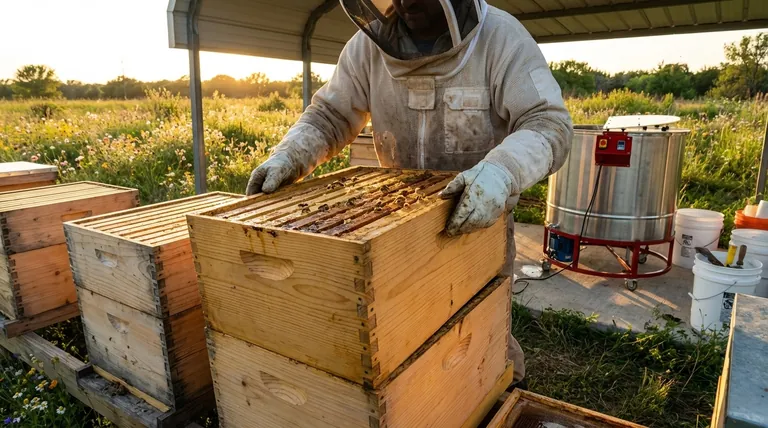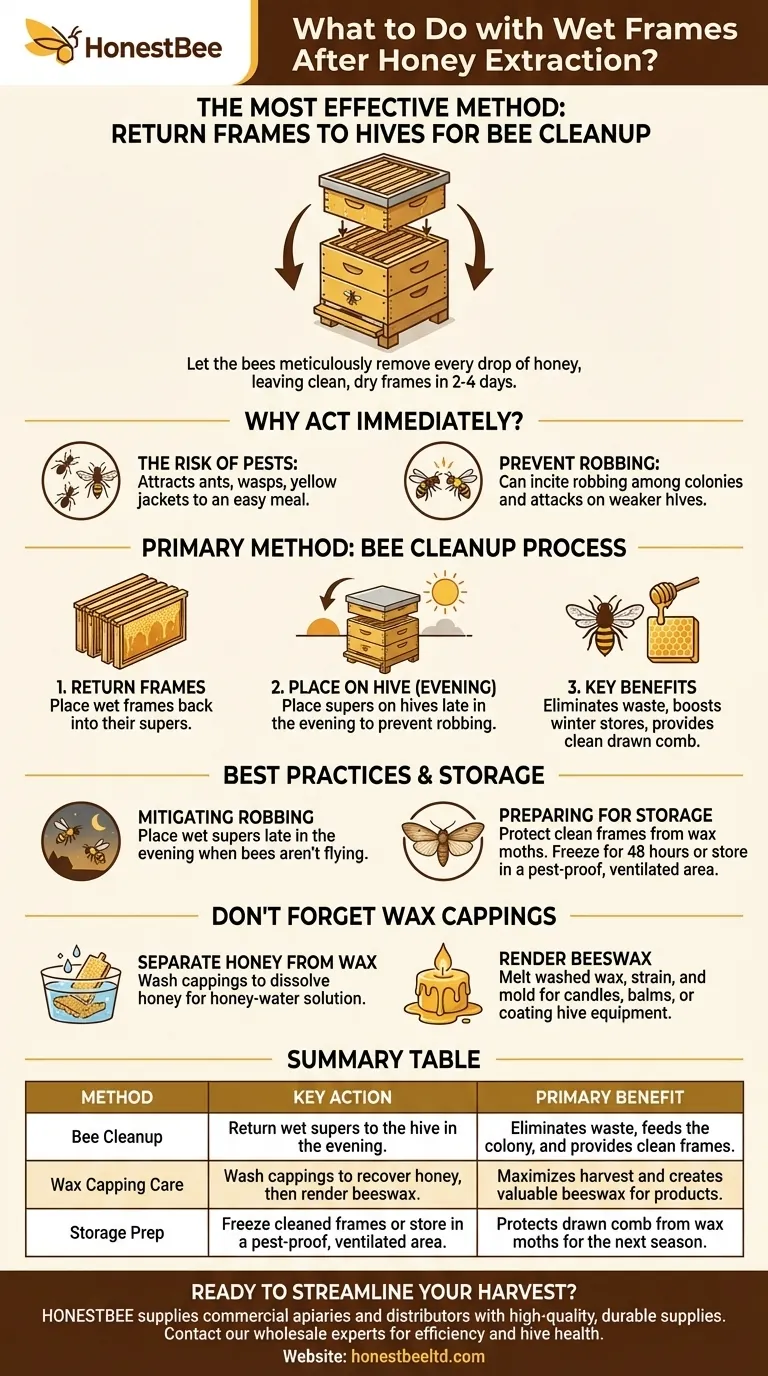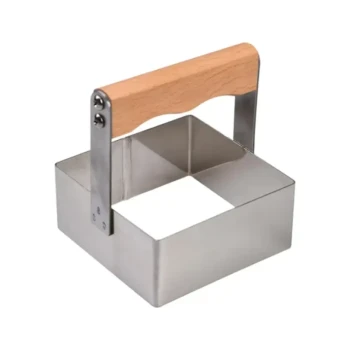The most effective and common practice for dealing with wet honey frames is to return them to your hives for the bees to clean. By placing the supers with the wet frames back on the hive, the bees will meticulously remove every last drop of honey within a few days, leaving you with clean, dry frames ready for storage.
Your core challenge after honey extraction is managing the sticky residue on your frames, which can attract pests and create a mess. The simplest solution is also the most beneficial for your colony: let the bees do the cleanup work for you.

Why You Must Address Wet Frames Immediately
After you've extracted honey, the frames are still coated in a thin, sticky layer of honey. This residue, while seemingly small, presents two significant challenges that require immediate attention.
The Risk of Pests
Wet frames left in the open are a powerful attractant for pests. Ants, wasps, yellow jackets, and other insects will be drawn to the easy meal, creating a nuisance and potentially threatening your nearby hives.
Preventing Robbing Behavior
Leaving wet frames exposed can also incite "robbing" among bee colonies. Bees from other hives will discover the food source, and this can lead to them attacking your weaker hives in an attempt to steal their stores.
The Primary Method: Letting the Bees Clean Up
The most efficient and beneficial way to handle wet frames is to enlist the help of the bees who made the honey in the first place.
The Process Explained
The process is straightforward. Place the wet frames back into the supers they came from. Then, place these supers back on top of the hives they were taken from, typically above the inner cover.
Key Benefits for Your Colony
This method eliminates waste by returning the residual honey to the colony. The bees will clean the frames and move the honey down into the brood boxes, providing them with a valuable food source and boosting their winter stores.
How Long Does It Take?
The bees are remarkably efficient. In most cases, they will have the frames completely clean and dry within two to four days, depending on the strength of the colony and the weather.
Understanding the Trade-offs and Best Practices
While returning frames to the hive is the best method, it's important to do it correctly to avoid creating new problems.
Mitigating the Risk of Robbing
Placing wet supers on a hive can sometimes trigger a feeding frenzy that attracts robber bees. To prevent this, place the wet supers on the hives late in the evening when the bees have ceased flying for the day. This gives the colony time to settle in and claim the resources before outside bees become active the next morning.
Preparing Frames for Storage
Once the bees have cleaned the frames, you are left with clean, drawn-out comb. This is a valuable resource for the next season. However, it is highly susceptible to damage from wax moths if stored improperly.
Proper Storage Techniques
After removing the now-dry frames from the hive, you must protect them. The most common methods are to freeze the frames for 48 hours to kill any wax moth eggs or larvae, or to store the supers stacked in a well-ventilated, pest-proof location.
Don't Forget the Wax Cappings
The wax cappings sliced off the frames during extraction are also a valuable resource, rich with residual honey.
Separating Honey from Wax
You can separate the remaining honey from the wax by washing the cappings in cold or lukewarm water. The water will dissolve the honey, creating a honey-water solution you can use, while leaving the wax behind.
Rendering and Using Beeswax
After washing and drying, the wax can be melted down in a double boiler. Strain the melted wax through cheesecloth to remove impurities. This rendered beeswax can be poured into molds to form blocks, which can then be used for making candles, balms, soaps, or for coating new wooden hive equipment.
Making the Right Choice for Your Post-Extraction Goal
Your immediate actions after extracting honey are crucial for hive health and equipment longevity. Your approach should be guided by your primary objective.
- If your primary focus is simplicity and bee health: Return the wet frames to a strong hive in the evening and let the bees clean them for a few days.
- If your primary focus is preventing robbing: Never leave wet frames or equipment out in the open and always place them on hives late in the day.
- If your primary focus is maximizing your harvest: Wash your wax cappings to recover the residual honey before you render the wax.
- If your primary focus is preparing for next season: Ensure your cleaned frames are protected from wax moths by freezing or storing them in a secure, well-ventilated area.
Properly managing your wet frames is the final step in a successful honey harvest and sets you up for a strong start next season.
Summary Table:
| Method | Key Action | Primary Benefit |
|---|---|---|
| Bee Cleanup | Return wet supers to the hive in the evening. | Eliminates waste, feeds the colony, and provides clean frames. |
| Wax Capping Care | Wash cappings to recover honey, then render beeswax. | Maximizes harvest and creates valuable beeswax for products. |
| Storage Prep | Freeze cleaned frames or store in a pest-proof, ventilated area. | Protects drawn comb from wax moths for the next season. |
Ready to streamline your honey harvest and protect your investment?
Managing wet frames is just one part of successful beekeeping. At HONESTBEE, we supply commercial apiaries and beekeeping equipment distributors with the high-quality, durable supplies needed for every step of the process—from extraction to storage.
Let us help you equip your operation for maximum efficiency and hive health. Contact our wholesale experts today to discuss your needs.
Visual Guide

Related Products
- HONESTBEE 72 Frame Industrial Electric Honey Extractor for Beekeeping
- 2 Frame Stainless Steel Manual Honey Spinner Extractor for Beekeeping
- HONESTBEE 3-Frame Manual Acrylic Honey Extractor
- electric honey extractor honey centrifuge 3 frame honey extractor stainless steel honey frame extractor
- 40 Frame Commercial Electric Honey Extractor for Beekeeping
People Also Ask
- Why is preserving honeycomb integrity important, and how do automated extractors help? Boost Hive Health & Honey Yields
- How is honey harvested from Langstroth hives? A Guide to Efficient, Comb-Preserving Extraction
- How do automatic honey extractors function? Achieve High-Efficiency Honey Harvesting
- What are the advantages of automatic honey extractors? Scale Your Apiary with Unmatched Efficiency
- What are the advantages of automated honey extractors in terms of time efficiency? Boost Your Harvest Speed



















